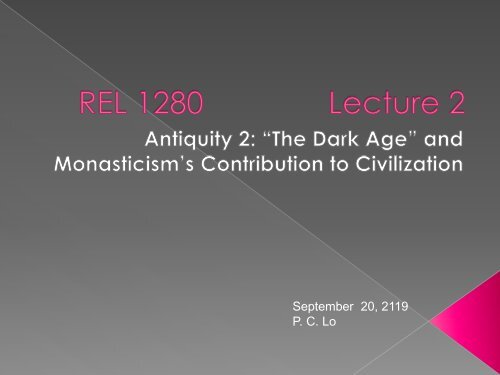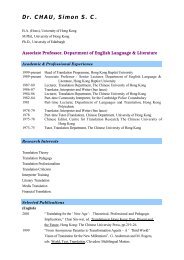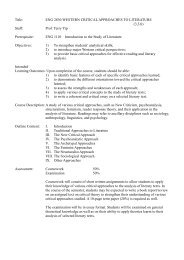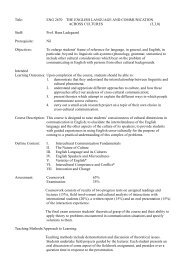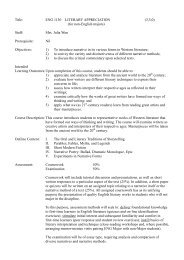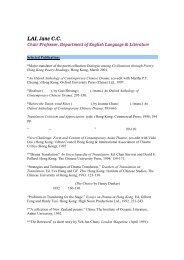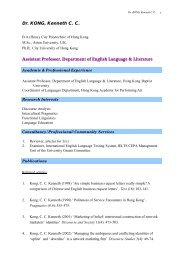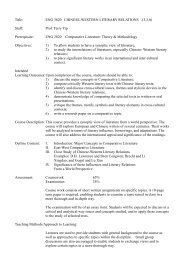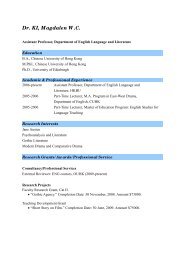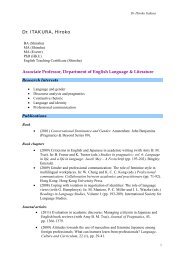Reading (2)
Reading (2)
Reading (2)
You also want an ePaper? Increase the reach of your titles
YUMPU automatically turns print PDFs into web optimized ePapers that Google loves.
September 20, 2119<br />
P. C. Lo
A. The Fall of the Roman Empire<br />
B. The ‚Dark Age‛<br />
C. How the Monks Saved Western<br />
European Civilization<br />
Irish contribution<br />
Benedict‟s contribution<br />
Non-Christian monasticism and other<br />
Civilizations<br />
copyright P C lo 2
姚介厚, 李鹏程, 杨深著,《西歐文明》,頁<br />
155-59。<br />
經濟<br />
政治<br />
文化<br />
蠻族入侵<br />
copyright P C lo 3
‚羅馬民族高昂、進取的道德精神已喪失殆<br />
盡,社會道德風氣極為敗壞‛<br />
‚羅馬全年娛樂假日公元1世紀時為66天,4<br />
世紀時竟達175天,近半年時日沉湎于觀看奴<br />
隸角鬥、鬥獸、海戰、戲劇等表演‛(頁157)<br />
copyright P C lo 4
copyright P C lo 5
匈奴人(Huns),日耳曼諸部落<br />
(Germanic tribes)武裝非法移民<br />
《西歐文明》,頁158。漢帝國與羅馬帝國<br />
3次大入侵及洗劫<br />
‚vandalism”<br />
Hungary<br />
Germanic tribes – Angles, Saxons, Jutes,<br />
Franks<br />
Angles Angland England<br />
copyright P C lo 6
copyright P C lo 7
copyright P C lo 8
copyright P C lo 9<br />
AD 476<br />
(南北朝)
《關於羅馬人的二十個問題》,頁163。<br />
copyright P C lo 10
“the growth of so mighty an empire as<br />
Rome‟s was by no means inevitable.<br />
Rome‟s greatness had come from<br />
conquests that provided the Romans<br />
with the means to expand still further,<br />
until there were not enough Romans to<br />
conquer and govern any more peoples<br />
and territory.<br />
copyright P C lo 11
“When pressure from outsiders grew, the<br />
Romans lacked the resources to<br />
advance and defeat the enemy as in<br />
the past…Without new conquests to<br />
provide the immense wealth needed to<br />
defend and maintain internal prosperity,<br />
the Romans finally yielded to<br />
unprecedented onslaughts by fierce<br />
and numerous attackers.”<br />
copyright P C lo 12
“Like similar empires<br />
in the ancient world,<br />
it had been unable<br />
to sustain its<br />
„Immoderate<br />
greatness‟” (Kagan,<br />
Ozment, Turner, The<br />
Western Heritage, 10 th<br />
ed. 2010, p.162)<br />
copyright P C lo 13
認識真正的中世紀<br />
<strong>Reading</strong> (1):姚介厚、李鹏程、 杨深著,<br />
《西歐文明》,頁163-166。(‚如何認識西<br />
歐中世紀文明‛)<br />
早期中世紀(Early Middle Ages)<br />
鼎盛期中世紀(High Middle Ages)<br />
後期中世紀(Late Middle Ages)<br />
copyright P C lo 14
‚從西羅馬帝國滅亡到約公元1000年的500餘<br />
年間,西歐由於日耳曼蠻族入侵和公元9世紀<br />
斯坎的納維亞半島蠻族南侵,確實兩番出現<br />
了戰亂頻仍、經濟衰敗、政局混亂、古希臘<br />
羅馬文化傳統慘遭破壞殆盡的滿目瘡痍景象<br />
,看來是一種文明的大倒退,所謂中世紀是<br />
‘黑暗時代’,主要是就此而言。‛(姚介<br />
厚、李鹏程、 杨深著,《西歐文明》,頁<br />
164)<br />
copyright P C lo 15
Buildings in Rome crumbled<br />
Looting<br />
Highway robbers<br />
Highway police and customs guards extort<br />
bribes<br />
Kidnapping and trafficking of children<br />
Enslavement of freemen and women<br />
Burned libraries<br />
copyright P C lo 16
Homer and Virgil and all of classical poetry<br />
Herodotus and Tacitus and all of classical<br />
history<br />
Demosthenes and Cicero and all of<br />
classical oratory<br />
Plato and Aristotle and all of Greek<br />
philosophy<br />
Plotinus and Porphyry and all the<br />
subsequent commentary<br />
Tragedies of Aeschylus, Sophocles, and<br />
Euripides (really lost)<br />
copyright P C lo 17
‚西羅馬帝國滅於蠻族之手,主要是因為它自身已經<br />
完全腐敗了,已無抵御強敵之力;羅馬文明向中世<br />
紀文明的轉變也得靠蠻族的外部力量,因為衰落的<br />
羅馬文明已完全失去自我革新的機制與活力。西歐<br />
的這種階段性文明的轉變是極為痛苦、曲折的。羅<br />
馬文明的輝煌成就慘遭毀滅性破壞,希臘羅馬的精<br />
神瀕于滅絕,只在基督教內部以神學形式有所傳承,<br />
又靠阿拉伯民族保存其文化遺產,直到中世紀盛期<br />
和至文藝復興時期才得以重放光彩。西歐文明受嚴<br />
重挫折,它走上封建化道路經歷了漫長的所謂‘黑<br />
暗時期’,文明的轉型艱難地經歷了幾個世紀。<br />
copyright P C lo 18
與此相比較,古代中國從奴隸制向封建制的社<br />
會轉型,雖然從戰國至秦漢也經歷了內戰,<br />
但主要是通過中華文明(文化上主要是儒家、<br />
法家、道家等)自身內部的變革機制實現的,<br />
并非在外部蠻族力量毀滅性的打擊后才完成<br />
自身的階段性文明轉型,古代中華文明的這<br />
種轉型相對平和而有連續性。中世紀千餘年<br />
中華文明比西歐中世紀文明更為優越、繁盛,<br />
其主要原因之一,是它有自身變革的機制與<br />
活力,保持了文明傳統的延續性。‛(姚介厚,<br />
李鹏程, 杨深著,《西歐文明》,頁159-160。)<br />
與五胡亂華比較<br />
copyright P C lo 19
Catholic<br />
Church<br />
公教<br />
Protestant<br />
Church<br />
新教<br />
copyright P C lo 20<br />
Orthodox<br />
Church<br />
正教<br />
Byzantium<br />
拜占庭皇國
Asceticism(禁慾主義,苦行/苦修主義)<br />
Self-denial (money, sex, power, comfort,<br />
companions, etc) union with God<br />
Anthony of Egypt (c.251-356); hermit<br />
Solitary, or in community<br />
“monk” (monachos) – “lonely one”<br />
“monastery” (monasterion) – “house of<br />
lone ones,” a community in which a<br />
large number of lonely ones living<br />
together<br />
copyright P C lo 21
“I hereby renounce my parents, my<br />
brothers and relatives, my friends, my<br />
possessions and my property, and the vain<br />
and empty glory and pleasure of this<br />
world. I also renounce my own will, for the<br />
will of God. I accept all the hardships of<br />
monastic life, and take the vows of purity,<br />
chastity, and poverty, in the hope of<br />
heaven; and I promise to remain a monk in<br />
this monastery all the days of my life.”<br />
copyright P C lo 22
“A monk‟s purpose in retiring<br />
to a monastery was to<br />
cultivate a more disciplined<br />
spiritual life… The monks‟<br />
intention had not been to<br />
perform great tasks for<br />
European civilization, yet as<br />
time went on, they came to<br />
appreciate the task for<br />
which the times seemed to<br />
have called them.” (Woods,<br />
p.27)<br />
copyright P C lo 23
<strong>Reading</strong> (2):<br />
Chapter 3: “The Monks of the<br />
West and the Formation of the<br />
Western Tradition,” pp.47-72.<br />
中譯本,頁40-67<br />
copyright P C lo 24
“the monastery was the most typical<br />
cultural institution throughout the whole<br />
period that extends from the decline of<br />
classical civilization to the rise of the<br />
European universities in the twelfth<br />
century – upwards of seven hundred<br />
years.” (Dawson, p.47)<br />
copyright P C lo 25
“In this new environment monasticism<br />
inevitably tended to assume a role of<br />
cultural leadership foreign to the original<br />
spirit of the institution.<br />
The monks had to instruct their converts not<br />
only in Christian doctrine but in the Latin<br />
tongue…<br />
They had to teach reading and writing and<br />
those arts and sciences which were<br />
necessary for the maintenance of the<br />
Church and liturgy,<br />
such as calligraphy, painting, music and,<br />
above all, chronology and the knowledge<br />
of the calendar…” (Dawson, p.55)<br />
copyright P C lo 26
“Here [Ireland], far from the<br />
barbarian despoliation [掠<br />
奪] of the continent, monks<br />
and scribes laboriously,<br />
lovingly, even playfully<br />
preserved the West‟s<br />
written treasury. With the<br />
return of stability in Europe,<br />
these Irish scholars were<br />
instrumental in spreading<br />
learning. Thus the Irish not<br />
only were conservators of<br />
civilization, but became<br />
shapers of the medieval<br />
mind, putting their unique<br />
stamp on Western culture.”<br />
(book description on back)<br />
copyright P C lo 27
“Wherever they went the Irish brought with<br />
them their books, many unseen in<br />
Europe for centuries… Wherever they<br />
went they brought their love of learning<br />
and their skills in bookmaking. In the<br />
bays and valleys of their exile, they<br />
reestablished literacy and breathed new<br />
life into the exhausted literary culture of<br />
Europe. And that is how the Irish saved<br />
civilization.” (Cahill, p.196)<br />
copyright P C lo 28
“this new learning had to compete in<br />
Ireland with a very ancient and<br />
elaborate system of vernacular culture<br />
and education, which had been<br />
handed down for centuries by the<br />
sacred order of seers and poets who<br />
held a very important place in Irish<br />
society.<br />
copyright P C lo 29
“The representatives of the new culture could<br />
only triumph by meeting their rivals on their<br />
own ground, as men of learning and<br />
masters of the word of power, and<br />
therefore it was natural and inevitable that<br />
Irish monasticism should acquire many of<br />
the features of the old learned class and<br />
that the monasteries should become not<br />
only abodes of prayer and asceticism but<br />
also schools and centres of learning.”<br />
(Dawson, p.58-9)<br />
copyright P C lo 30
(NB: not the same Benedict to be mentioned<br />
later)<br />
“on his repeated journeys to Rome and Gaul<br />
he brought back to England a wealth of<br />
manuscripts, paintings, relics and vestments, as<br />
well as masons and glaziers and singers for the<br />
adornment and service of the Church.”<br />
“Hence it was in Northumbria that Anglo-Saxon<br />
culture, and perhaps the whole culture of<br />
Western monasticism in the Dark Ages,<br />
achieved their climax at the beginning of the<br />
eighth century. (Dawson, p.65-66)<br />
copyright P C lo 31
“the monks taught metallurgy, introduced<br />
new crops, copied ancient texts,<br />
preserved literacy, pioneered in<br />
technology, invented champagne,<br />
improved the European landscape,<br />
provided for wanderers of every stripe,<br />
and looked after the lost and<br />
shipwrecked.” (Woods, p.45)<br />
copyright P C lo 32
“The influence of monasticism upon the<br />
society of the early Middle Ages would<br />
be difficult to exaggerate. The monks<br />
were generally the best farmers in<br />
Europe; they reclaimed waste lands,<br />
drained swamps, and made numerous<br />
discoveries relating to the improvement<br />
of the soil. They preserved some of the<br />
building skill of the Romans and<br />
achieved noteworthy progress in many<br />
of the industrial arts, especially in wood<br />
carving, metal-working, weaving, glassmaking,<br />
and brewing.<br />
copyright P C lo 33
It was the monks,<br />
furthermore, who<br />
wrote most of the<br />
books, copied the<br />
ancient manuscripts,<br />
and maintained the<br />
majority of the<br />
schools and libraries<br />
and nearly all of the<br />
hospitals that existed<br />
during the early<br />
Middle Ages.”<br />
Edward McNall Burns and<br />
Philip Lee Ralph, World<br />
Civilizations, 5 th ed., 1974,<br />
vol. 1, p.339<br />
copyright P C lo 34
copyright P C lo 35
copyright P C lo 36
Scriptorum(繕寫室),<br />
where monks copied<br />
books and preserved<br />
civilization during the<br />
dark ages<br />
copyright P C lo 37
Gregory the Great at his<br />
writing desk<br />
copyright P C lo 38
copyright P C lo 39
本篤<br />
c. 480 - c. 547<br />
1 st sack of Rome: 410<br />
Constant wars as<br />
barbarians kept<br />
invading the Italian<br />
peninsula<br />
Invited to be an<br />
abbot<br />
Founded<br />
monasteries<br />
Visited by a king<br />
copyright P C lo 40
monastery<br />
at Monte Cassino<br />
copyright P C lo 41
A work of only 73 short chapters.<br />
Its wisdom is of two kinds: spiritual (how to live a<br />
Christocentric life on earth) and administrative<br />
(how to run a monastery efficiently).<br />
More than half the chapters describe how to<br />
be obedient and humble, and what to do<br />
when a member of the community is not.<br />
About one-fourth regulate the worship of God<br />
One-tenth outline how, and by whom, the<br />
monastery should be managed.<br />
And another tenth specifically describe the<br />
abbot‟s pastoral duties.<br />
“Benedict of Nursia”<br />
Wikipedia<br />
copyright P C lo 42
“Let all guests who arrive be received as<br />
Christ, because He will say: „I was a stranger<br />
and you took Me in‟ (Mt 25:35).<br />
In the greeting let all humility be shown to<br />
the guests, whether coming or going; with<br />
the head bowed down or the whole body<br />
prostrate on the ground, let Christ be adored<br />
in them as He is also received.<br />
Let the greatest care be taken, especially in<br />
the reception of the poor and travelers,<br />
because Christ is received more specially in<br />
them;”<br />
http://www.kansasmonks.org/RuleOfStBenedict.html#ch53<br />
copyright P C lo 43
“In fact, the Benedictine Abbey was a selfcontained<br />
economic organism, like the<br />
villa of a Roman landowner, save that<br />
the monks were themselves the workers<br />
and the old classical contrast between<br />
servile work and free leisure no longer<br />
obtained.” (Dawson, p.51)<br />
copyright P C lo 44
“Idleness is the enemy of the soul; and<br />
therefore the brethren ought to be<br />
employed in manual labor at certain times,<br />
at others, in devout reading….<br />
If, however, the needs of the place, or<br />
poverty should require that they do the<br />
work of gathering the harvest themselves,<br />
let them not be downcast, for then are they<br />
monks in truth, if they live by the work of<br />
their hands, as did also our forefathers and<br />
the Apostles.”<br />
copyright P C lo 45
“By its sanctification of work and poverty it<br />
revolutionized both the order of social<br />
values which had dominated the slaveowning<br />
society of the Empire and that<br />
which was expressed in the aristocratic<br />
warrior ethos of the barbarian conquerors,<br />
so that the peasant, who for so long had<br />
been the forgotten bearer of the whole<br />
social structure, found his way of life<br />
recognized and honoured by the highest<br />
spiritual authority of the age.” (Dawson,<br />
p.56)<br />
copyright P C lo 46
“Silent men were observed about the<br />
country, or discovered in the forest,<br />
digging, clearing and building; and other<br />
silent men, not seen, were sitting in the<br />
cold cloister, tiring their eyes and<br />
keeping their attention on the stretch,<br />
while they painfully copied and<br />
recopied the manuscripts which they<br />
had saved.<br />
copyright P C lo 47
“There was no one who contended or<br />
cried out, or drew attention to what was<br />
going on, but by degrees the woody<br />
swamp became a hermitage, a religious<br />
house, a farm, an abbey, a village, a<br />
seminary, a school of learning and a city.”<br />
(Dawson, p.58)<br />
copyright P C lo 48
“For centuries, as scholarship became one<br />
of the recognized forms of the monk‟s<br />
labor, the monasteries were the<br />
guardians of the western intellectual<br />
heritage from the Greco-Roman world.<br />
Especially in what we usually call the<br />
Dark Ages, roughly the five hundred<br />
years after 500 A.D., the Benedictine<br />
Order was at the front of the civilizing<br />
forces of the West.”<br />
Brinton, Christopher, Wolff, A History of Civilization, 3 rd ed., p.157.<br />
copyright P C lo 49
“Their disciplined organization and<br />
devotion to hard work made the<br />
Benedictines an economic and political<br />
power as well as a spiritual force<br />
wherever they settled.”<br />
Kagan, Ozment, Turner, The Western Heritage, 10 th<br />
ed. (2010), p.184<br />
copyright P C lo 50
Pope Gregory I was elected as Pope in<br />
590. He was the first monk to be so<br />
elected, and popularized Benedictine<br />
monasticism.<br />
Charlemagne (查理曼大帝 747-814)<br />
imposed the Rule on all monasteries in<br />
the Holy Roman Empire<br />
copyright P C lo 51
Other ecclesiastical and liturgical reform<br />
“its [the Empire‟s] work of cultural and<br />
religious unification remained the<br />
permanent foundation of all the later<br />
medieval developments.” (Dawson, p.69)<br />
copyright P C lo 52
“And after the fall of the Empire it was the<br />
great monasteries…that were the only<br />
remaining islands of intellectual life amidst<br />
the returning flood of barbarism which once<br />
again threatened to submerge Western<br />
Christendom.<br />
“Ninety-nine out of a hundred monasteries<br />
could be burnt and the monks killed or<br />
driven out, and yet the whole tradition<br />
could be reconstituted from the one<br />
survivor,.. (Dawson, p.72)<br />
copyright P C lo 53
“following the same rule, singing the same<br />
liturgy, reading the same books and<br />
thinking the same thoughts as their<br />
predecessors. …with the result that a<br />
century later the Norman and English<br />
monasteries were again among the<br />
leaders of Western culture.” (Dawson,<br />
p.72)<br />
copyright P C lo 54
“by the beginning of the fourteenth<br />
century, the [Benedictine] order had<br />
supplied the Church with 24 popes, 200<br />
cardinals, 7,000 archbishops, and 1,500<br />
canonized saints. At its height, the<br />
Benedictine order could boast 37,000<br />
monasteries.” (Woods, How the Catholic Church Built<br />
Western Civilization, p.28)<br />
copyright P C lo 55
1964, Pope Paul VI named St. Benedict as<br />
patron saint of Europe<br />
9 April, 2008, Pope Benedict XVI discussed<br />
the influence St. Benedict had on Western<br />
Europe. The pope said that “with his life and<br />
work St. Benedict exercised a fundamental<br />
influence on the development of European<br />
civilization and culture” and helped Europe<br />
to emerge from the "dark night of history"<br />
that followed the fall of the Roman empire<br />
copyright P C lo 56
Monks – lonely ones<br />
Renouncing civilization<br />
Preserving and transmitting civilization !<br />
copyright P C lo 57
copyright P C lo 58
copyright P C lo 59
copyright P C lo 60
copyright P C lo 61
位於甘肅省 甘南藏族自治州 夏河縣<br />
藏傳佛教格魯派六大寺院之一<br />
3000人<br />
尚有藏经楼、印经院等<br />
《維基百科》<br />
copyright P C lo 62
copyright P C lo 63
聞思學院 (顯宗學院/哲學學院)<br />
續部上學院<br />
續部下學院<br />
時輪學院<br />
醫藥學院<br />
喜金剛學院<br />
copyright P C lo 64
copyright P C lo 65
copyright P C lo 66
copyright P C lo 67
“there have been other cultures – Tibet,<br />
Burma and Ceylon, for example – in<br />
which a non-Christian monasticim<br />
played a somewhat similar role.”<br />
(Dawson, p.47)<br />
copyright P C lo 68
中文,非基督徒論述,圖書館有:<br />
王亞平著,《修道院的變遷》。<br />
姚介厚, 李鹏程, 杨深著,《西歐文明》<br />
(2002,2007),上冊,頁194-195。(‚修<br />
道院制度的衍變‛)<br />
李秋零、田薇著,《神光沐浴下的文化再生》<br />
(2000),頁102-110。(‚西方修道制度的<br />
形成及其文化意義‛)<br />
田薇著,《信仰與理性 : 中世紀基督敎文化的<br />
興衰》(2001),頁54-60.(‚修道院 – 修<br />
道制度與文化的保存‛)<br />
copyright P C lo 69
copyright P C lo 70
燕京大學神學院 1936 / 2000 (NB)<br />
copyright P C lo 71
‚黑暗時期‛與歐洲接受基督宗教有甚麼關<br />
係?<br />
修道院對歐洲文明的貢獻是時世造英雄?還<br />
是英雄造時世?<br />
For <strong>Reading</strong> (2), just acquire the main<br />
ideas, ignore most names of people<br />
今天教會該如何回應時代社會的需要?<br />
今天教會有甚麼重要資源可以與社會中匱乏者分享?<br />
香港教會目前有甚麼關懷社會行動?<br />
copyright P C lo 72


